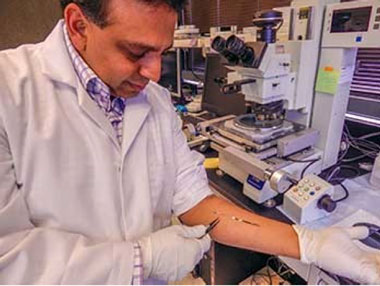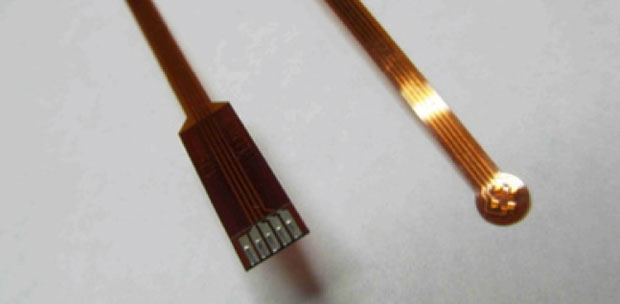Neural System
In 2015, the Defense Advanced Research Projects Agency selected Lawrence Livermore to join a collaborative research team that intends to build the world's first neural system that will enable naturalistic feeling and movement in prosthetic hands. Known as HAPTIX (hand proprioception and touch interfaces), the program seeks to provide wounded service members with dexterous control over advanced prosthetic devices that substitute for amputated hands. If successful, HAPTIX also intends to reduce "phantom limb" pain, a sensation some amputees can feel despite the removal of a limb. This strategic partnership effort was an outgrowth of LDRD project 12-LW-008, “Comprehensive Study and Treatment of Major Depressive Disorder Using Electrical and Chemical Methods,” in which investigators successfully designed and developed a micro-fabricated neural interface appropriate for stimulation and recording brain activity in a large animal model.
Contact Stress Sensor
In FY15, Lawrence Livermore’s contact stress sensor technology, based on a micro-electromechanical system and developed with support from LDRD, was licensed to Livermore-based Micrometrics, Inc. The company will offer the contact stress sensor for a large variety of applications, such as haptic interfaces, which provides users with a more realistic sense of touch while controlling robotics and prosthetic fittings. The technology can also be used in cartilage research, helmet instrumentation, tire molding, wearable health devices (shoes), and lithium-ion battery-monitoring systems. Micrometrics will also supply the sensor for national defense needs. Originally designed to meet internal LLNL needs such as weapons health monitoring, traumatic brain injury studies, and lithium-ion battery monitoring, the sensor reproducibly measures loads at an interface while being suitable for product embedment because it does not lose its calibration with load cycling or time. This feature, its high bandwidth, and its thinness strongly differentiates the sensor from its competitors. The technology received early support from LDRD project 06-SI-005, “Transformational Materials Initiative,” which successfully provided key advanced material and sensor concepts and prototypes to the weapons program.
Contact stress sensor technology for national defense, medical, fabrication, and battery-monitoring applications.







